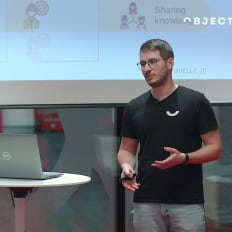
Objectbay
Mutation Testing
Description
Alexander Knapp von Objectbay widmet sich in seinem devjobs.at TechTalk dem Thema Mutation Testing – was es ist und wie jedes Software Projekt davon profitieren kann.
By playing the video, you agree to data transfer to YouTube and acknowledge the privacy policy.
Video Summary
In “Mutation Testing,” Alexander Knapp of Objectbay explains why code coverage and complexity metrics alone fall short and how tests without assertions can game the numbers while still missing defects. He details how mutation testing injects small faults—flipped comparison operators, altered return values, removed logical operators—runs the unchanged test suite, and uses killed vs. surviving mutants to derive a more meaningful mutation coverage. Through a PIT demo (including a factorial example), he shows how to plug the gaps by adding tests or tightening assertions, suggests running it periodically (e.g., per release) due to compute cost, and points to tools across ecosystems for Java, Ruby, C#, Python, and JavaScript/TypeScript.
Mutation Testing That Matters: Why Line Coverage Misleads and How to Make Tests Prove Themselves – Insights from “Mutation Testing” by Alexander Knapp (Objectbay)
Setting the stage: From counting lines to proving correctness
In “Mutation Testing,” Alexander Knapp (Objectbay) lays out a simple but sobering point: traditional code coverage is a weak proxy for test quality. You can hit impressive percentages without asserting a single expectation. Mutation testing turns that dynamic on its head. Rather than testing production code, it tests your tests.
The session walked through the essentials: what mutation testing is, why we need it today, and how it works in practice. We captured the key arguments, the demo highlights, and the practical takeaways for engineering teams.
About the speaker and the company: Alexander Knapp is a Fullstack Developer at Objectbay. The company was founded in 2006, grows “slowly but healthily,” operates across three locations (Traun, Salzburg, Vienna), has more than 50 employees, and has delivered around 160 customer projects and products successfully. The technology stack is broad; the historical Java focus is no longer a constraint.
Quality signals: Complexity, comprehensibility, and coverage (used carefully)
Before mutation testing enters the picture, it helps to revisit the common quality markers.
Cyclomatic complexity: Where hotspots tend to live
If we model software as a graph of nodes (statements) and edges (flows between statements), cyclomatic complexity assigns a numeric value to complexity. Higher values often pinpoint hotspots—areas of lower maintainability and higher bug risk. Useful as a warning sign, insufficient as a sole decision driver.
Cognitive complexity: Can humans understand this?
In the “SonarCube” ecosystem, cognitive complexity is a pragmatic guide. IDE plugins will nudge you when understandability drops and ask you to reduce complexity. The human angle matters: the harder a piece of code is to comprehend, the harder it is to maintain—and the easier it is for defects to slip through.
Coverage: function, condition, statement, branch
Many teams enforce coverage targets. Typical variants:
- Function coverage: counts how many functions a test calls. Crude; executing a function doesn’t say anything about internal branches.
- Condition coverage: checks boolean conditions; less often the primary yardstick in practice.
- Statement/Branch coverage: the most common choices in real projects. They measure how many statements and branches tests have executed.
Coverage tools count execution, not correctness. And that’s the heart of the problem.
Why coverage alone is fragile: late bugs are costly, incentives get skewed
A well-known development truth remains: the later a bug is detected, the more expensive it is to fix. That’s why we want metrics early—starting in requirements and extending through the first unit tests. Yet coverage has two big blind spots that Alexander Knapp called out clearly:
1) Vague specs: Many projects require “high coverage” without specifying a precise threshold—or which flavor of coverage they mean. That invites gaming.
2) Coverage measures execution, not verification: A test that merely runs code still contributes to coverage—even if it has zero assertions. The result is glossy numbers without substance.
Example from the session: A JUnit test calls a method with two paths but contains no assertions. The coverage report proudly says 100%. What it says about correctness: nothing.
This isn’t hypothetical. Knapp recounted an anecdote from a large German enterprise running offshore development. Teams were mandated to deliver 90% coverage—an unrealistic target at the scale of millions of lines. The “solution” was to write hundreds of empty unit tests that simply executed code. The metric turned green; the quality did not. His verdict: it’s cheating—sometimes deliberate, often unintentional. Either way, coverage alone isn’t a quality metric you can trust.
Good tests still miss things: the “Monday morning” operator bug
Even with “good” tests, we’re not safe. Knapp shared a simple scenario that rings true: during a refactoring, a comparison operator is accidentally flipped—greater-than becomes less-than. The code still compiles, the tests still run, and they stay green. Why? Because there aren’t enough test cases to hit the new, faulty behavior. The bug slips into production.
The lesson is straightforward: even with test plans, specifications, and test-driven development (TDD), we can’t foresee all real-world conditions and edge cases. Our brains can’t enumerate every path up front. Mutation testing addresses exactly that limitation.
Enter mutation testing: the technique that tests your tests
The core idea is not new. In the early 1970s, Richard Lipton formulated mutation analysis. The goal isn’t to test production code directly—it’s to check whether your testsuite is capable of catching the kinds of bugs that actually happen.
“Mutation testing tests my tests.”
Why did adoption pick up only in recent years? As Knapp noted, the approach is computationally intensive. You clone and modify production code into many variants and run the entire testsuite repeatedly. That’s far more feasible today than in the 70s and 80s, but Knapp’s advice is pragmatic: don’t wire it into every CI build or nightly. Running mutation testing per release, however, can be a very sensible quality gate.
How it works, in three steps
- Clone and mutate production code: the tool applies small, targeted changes—mutations that mimic realistic bugs.
- Run the existing testsuite unchanged: every mutation variant is tested with the same tests.
- Interpret results:
- Mutant “killed”: the test fails—good. The test detects the injected bug.
- Mutant “survived”: the test stays green—bad. A test case or a meaningful assertion is missing.
The hypothesis is simple: if tests don’t notice intentionally introduced defects, the tests aren’t good enough.
What kinds of mutations are created?
Knapp listed realistic, developer-like slip-ups captured as operators and expression changes:
- Inverting comparison operators (e.g., greater-than becomes less-than)
- Overriding return values (e.g., returning zero/null in integer-returning methods)
- Modifying or removing logical operators (e.g., AND/OR variants)
The exact set depends on the tool, but the intent is always the same: introduce small, plausible faults.
Rethinking the metric: mutation coverage over line/branch coverage
A highlight of the talk contrasted “line/branch coverage” with “mutation coverage.” Knapp illustrated this with a method computing factorial—containing several branches depending on the input argument. The team had written two test cases. Both passed.
Using Pit Mutation (a widely used tool in the Java world), the report showed many green lines but also some red ones. Red means the tool generated mutations at those locations, but the tests still passed. In other words: those mutants survived.
The numbers from the example:
- 11 mutations were applied.
- 9 mutants were killed—good.
- Mutation coverage: 82%.
- For comparison: line coverage was 91%.
The message is crisp: traditional coverage made the tests look better than they were. Mutation coverage revealed gaps that otherwise remained hidden. That’s why mutation coverage is the stronger indicator when you care about the actual effectiveness of your testsuite.
What to do when mutants survive: an actionable order of operations
Knapp’s recommended response to “red lines” in mutation reports is both practical and disciplined:
1) Write better tests: Add the missing test cases and sharpen assertions. This is the primary purpose of mutation testing—to expose and close test gaps.
2) Reduce redundant code: If formulating tests is unduly hard, structural redundancy might be a culprit. Less redundancy, fewer failure modes.
3) Investigate actual bugs (if needed): Finding production defects via these mutants is a side effect—not the focus. Only in the third step does it make sense to check for real issues in production code.
His overarching conclusion: if we know our tests work well, that’s a strong indicator of high-quality production code. And for that statement, mutation coverage is more meaningful than line or branch coverage. Put bluntly: you can “throw away” classic coverage as your main lever and use mutation coverage to steer.
Where mutation testing fits in the lifecycle
While the session centered on the why and how—not process dogma—two pragmatic usage notes stood out:
- Don’t burden every CI build: the approach is computationally heavy due to the multiplicity of mutations.
- Run it per release: as a quality gate, mutation testing flags test gaps reliably, and crucially, early enough.
For teams getting started, a simple playbook emerges:
- Keep the tests unchanged; configure the mutation tool.
- Study the report: which mutants survive? Which branches are untested? Where are assertions too weak?
- Iterate on tests: add cases, strengthen assertions.
- Track mutation coverage: not as a vanity number, but as a feedback loop for the capability of your tests.
Tooling landscape: Java, Ruby, C#, Python, JavaScript/TypeScript
Knapp listed a set of mature tools—each anchored in a particular ecosystem:
- Pit Mutation / Pit-Mutation-Testing for Java and Kotlin (the tool used in the example)
- Mutant for Ruby
- Visual Mutator for C#
- MutePy for Python
- Striker focusing on JavaScript and TypeScript; according to the talk, a Python variant exists as well
The spread underscores that mutation testing is no longer niche.
TDD helps—but it isn’t the final word
A common objection is: “We already practice test-driven development—why add mutation testing?” Knapp’s answer: TDD does improve test quality, but it doesn’t guarantee completeness. Humans can’t precompute every meaningful state or path. Mutation testing is the extra reality check that demonstrates whether your tests can catch the defects that actually matter.
What we learned from “Mutation Testing” — guidelines for engineering teams
The core lessons from this session are succinct:
- Coverage is not quality: executing code is not the same as verifying behavior. Empty tests can deliver coverage—and still test nothing.
- Make errors visible early: mutation testing injects controlled, small faults. If they go unnoticed, your tests are missing something.
- Mutation coverage beats line/branch coverage: in Knapp’s case, 82% mutation coverage vs. 91% line coverage exposes the quality gap.
- Focus on improving tests, not chasing production bugs: mutation testing evaluates the tests; real production defects discovered are a side effect.
- Be tactical: don’t wire it into every CI build. As a per-release quality gate, it shines.
“The goal is not to find bugs in production code, but to see whether my existing testsuite finds bugs.”
Company context: a quality mindset at Objectbay
Knapp closed by emphasizing Objectbay’s focus on quality. The team actively engages with metrics and tools that raise testability and maintainability. And Objectbay is looking for new colleagues—if you’re interested, reach out.
Our DevJobs.at takeaway
Mutation testing isn’t a nice-to-have. It’s the necessary next step if you want your tests to do more than color dashboards green. We found Alexander Knapp’s argument compelling: stop chasing coverage quotas and start stress-testing your tests. If deliberately injected faults go unnoticed, something’s missing—right where long-term stability is decided: in the tests themselves.
With accessible tools across ecosystems, the barrier to entry is low. We recommend using the next release cycle as a vehicle: configure mutation testing, examine the reports, and strengthen tests with purpose. Once established, mutation coverage is one of the rare metrics that measures capability, not activity—the capability to catch defects before they become production incidents.
That concludes our recap of “Mutation Testing” (Title: Mutation Testing, Speaker: Alexander Knapp, Company: Objectbay). We wish you success applying mutation testing—and building test suites that don’t just execute code, but prove correctness.
More Tech Talks
Objectbay Serverless Applications with AWS Lambda
Thomas Jäger von Objectbay geht in seinem devjobs.at TechTalk zu dem Thema Serverless Applications in die Tiefe und überprüft, ob die Marketing Slides von Amazon auch halten was sie versprechen.
Watch nowObjectbay Microservices for Front Ends
Michael Eder von Objectbay spricht in seinem devjobs.at TechTalk über einen Ansatz, wie man die gängige Architektur der Microservices auch im Front End anwenden könnte.
Watch nowObjectbay Die Wahl der richtigen Software Architektur
Alexander Knapp von Objectbay beschäftigt sich in seinem devjobs.at TechTalk mit der Herangehensweise, wie man aus einer Vielzahl an verschiedenen Software Architekturen die passende auswählt.
Watch now





